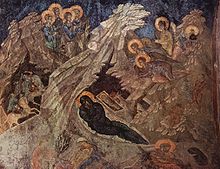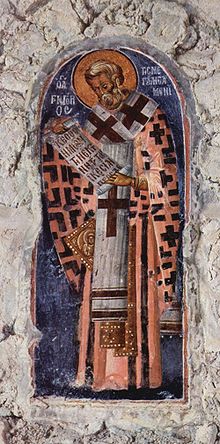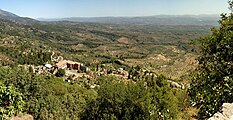Mystras

(1: main entrance; 2: Metropolis; 3: Evangelistria; 4: Agios Theodoros; 5: Hodigitria-Afendiko; 6: Gate to Monemvasia; 7: Agios Nikolaus; 8: ruler's palace with main square; 9: gate to Nauplion ; 10: Upper entrance to the citadel 11: Agia Sophia; 12: Small palace; 13: Citadel; 14: Mavroporta; 15: Pantanassa; 16: Agioi Taxiarches; 17: Frangopoulos house; 18: Peribleptos; 19: Agios Georgios; 20: Krevata House; 21: Gate to Marmara ; 22: Aï-Jannakis; 23: Laskaris House; 24: Agios Christophoros; 25: Ruins; 26: Agia Kyriaki)
Mystras or Mistra ( Greek Μυστράς ) is a Byzantine ruined city near the village of the same name in Greece , northwest of Sparta on a hill in front of the Taygetos Mountains.
history
The history of the mountain fortress Mystras begins with the Fourth Crusade (1202–1204). As a result, Gottfried I von Villehardouin from Bar-sur-Aube in northern France became the prince of Achaia when the Crusaders conquered the Peloponnese in 1206/1207 . He was followed by his son Gottfried II (r. 1218-1246), who established his residence in Lacedaemon , ancient Sparta . His brother Wilhelm II (reigned 1246–1278) conquered the rest of Laconia and in 1249 built a strong high fortress in the previously uninhabited Mystras, which was supposed to secure Lacedaemon. There were other castles in Monemvasia and probably on the Tigani peninsula. In 1259 , Prince Wilhelm II was captured by troops of the Byzantine emperor of Nikaia and could only buy himself free by relinquishing Mystras and other castles. The Greek residents of Sparta, tired of the foreign rule of the Crusaders, now settled in Mystras, only about three kilometers away. Below the castle, a flourishing town emerged that eventually numbered tens of thousands of inhabitants. Mystras became the cultural center of the region.
The now Byzantine areas around the castle were finally combined in 1348/1349 to form the Despotate Morea and ruled as a secondary byzantine princes. The famous philosopher Georgios Gemistos Plethon settled in Mystras in 1406 and renewed the Platonic and Neoplatonic philosophy; he was a leading figure in the cultural life of Mystras. The governors - with the title despots , hence the term despotate for the ruled area - were all members of the Byzantine imperial family of the palaeologists . One of them was Constantine, known as Constantine XI. was crowned last Byzantine emperor on January 6, 1449 in Mystras. The "Despot's Palace" of Mystras was the largest Byzantine representative building outside of Constantinople . In contrast to the sacred buildings of the city, it shows strong Italian influences.
In 1460 Mystras was conquered by the Ottomans . Now minarets also appeared between churches and monasteries. As a result of Francesco Morosini's campaign in the Peloponnese , the city came into Venetian possession in 1687 , but fell back to the Ottoman Turks in 1715. In 1770, during a Russo-Turkish war , the city began to fade; Auxiliary troops from what is now Albania, who invaded the Peloponnese on the orders of the Turks and to stop the Orlov revolt , devastated the city. Mystra's heyday was over for good. In the Greek struggle for freedom in 1825, the city was so destroyed that it was not rebuilt. Instead, Sparta , which had been abandoned centuries earlier, was rebuilt a little later .
architecture

Some churches with colorful wall paintings have been preserved (Agia Sophia, Agios Dimitrios); one of the monasteries, the Pantanassa monastery , is still inhabited.
The churches of Mystras are built in the so-called Mystras type , which is partly interpreted as a combination of Western-Latin and Byzantine structures: a second floor in the form of a cross-domed church was placed on a basilica . The main church (the Mitropolis ) is located on a 600 m high mountain and - like all buildings in the city - is a listed building. Also famous is the church of the former Peribleptos monastery , which was partly built into a rock grotto (the Demeter cave , which was probably a pagan sanctuary in ancient times) and, like many other churches in the city, was richly decorated with Byzantine frescoes.
In 1989, Mystras was included in the list of monuments of the world cultural heritage by UNESCO . The Despot's Palace is currently (2013) being extensively restored.
In the literature
Goethe , who himself never traveled to Greece, set up a literary monument to Mystras by being inspired by reports about the city to describe the crusader fortress near Sparta, where Faust meets the beautiful Helena .
literature
- Wolfgang von Löhneysen : Mistra. Greece's fate in the Middle Ages. Morea under the Franks, Byzantines and Ottomans . Prestel, Munich 1977, ISBN 3-7913-0405-4 .
- Steven Runciman : Mistra. Byzantine capital of the Peloponnese . Thames and Hudson, London 1980, ISBN 0-500-25071-5 .
- Manolis Chatzidakis: Mistra. The medieval city and the castle. Complete guide to palaces, churches and castles . Ekdotike Athenon, Athens 2001, ISBN 960-213-029-6 .
Web links
- Mystras, Greece. A Byzantine ruined city , treasures of the world - legacy of humanity , originally: Episode 41, SWR.de, (June 30, 1996), now on Youtube
- Photos and tourist information
- Entry on the UNESCO World Heritage Center website ( English and French ).
Individual evidence
- ↑ Alice-Mary Talbot: Constantine XI Palaiologos . In: Oxford Dictionary of Byzantium Vol. 1, p. 505.
Coordinates: 37 ° 3 ′ 59 ″ N , 22 ° 22 ′ 35 ″ E













